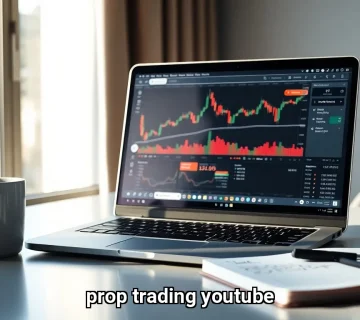Are you curious about the world of prop trading and wondering how traders leverage their firm’s capital to maximize profits? Whether you’re an aspiring trader, an investment firm, or simply fascinated by the inner workings of financial markets, understanding prop trading is essential. This comprehensive Prop Trading Guide is your gateway to uncovering the strategies, practices, and tools that define successful proprietary trading. From the basics of how firms allocate capital and evaluate traders to advanced risk management techniques, you’ll gain valuable insights into the high-stakes environment where skill, discipline, and technology intersect.
In an industry driven by rapid technological advancements and complex market dynamics, staying informed and prepared can make all the difference. This guide not only explains the operational mechanics behind prop trading firms but also offers practical tips on choosing the right partners, developing effective trading strategies, and leveraging cutting-edge platforms. Whether you’re looking to deepen your knowledge of proprietary trading strategies or seeking reliable resources to start your journey, this Prop Trading Guide equips you with the essential information to navigate and succeed in this competitive landscape. Dive in to explore the opportunities and challenges that define the world of prop trading today.
Understanding Proprietary Trading: An Introduction to Prop Trading
Proprietary trading, commonly known as prop trading, is a distinctive approach within the financial markets where firms use their own capital to execute trades rather than client funds. This strategy allows firms to pursue higher returns through sophisticated trading techniques, often involving complex derivatives, algorithmic strategies, and high-frequency trading. For aspiring traders and investment entities, understanding the operational mechanics of proprietary trading is essential, as it offers both lucrative opportunities and high risks.
Prop trading firms, such as Propx Pro, emphasize the importance of thorough knowledge and strategic planning in this field. The Prop Trading Guide serves as an essential resource for navigating this competitive environment, highlighting best practices, technological requirements, and regulatory considerations. These firms typically allocate capital based on a trader’s experience, past performance, and trading strategy, creating an environment where skill and discipline are rewarded. Aspiring traders must understand that success in prop trading depends heavily on their ability to manage risk, develop effective strategies, and adapt to rapidly changing market conditions.

Operational Mechanics of Prop Trading Firms
How Prop Trading Firms Allocate Capital
In a typical prop trading setup, the firm allocates a specific amount of capital to individual traders based on their experience, past performance, and trading strategy. This capital is used solely for trading activities; traders do not invest their own money but operate on the firm’s funds. The profits generated from these trades are usually shared between the firm and the trader according to a predefined profit-sharing arrangement. This structure incentivizes traders to perform well, as their earnings are directly tied to their trading success. The firm, on the other hand, benefits from the trader’s expertise and risk management skills, aiming for consistent profitability while safeguarding its capital through strict controls.
Evaluation Process for Aspiring Prop Traders
Traders looking to enter the world of proprietary trading should consult comprehensive resources like this Prop Trading Guide to understand the typical evaluation procedures. Before traders are granted access to significant capital, prop firms implement rigorous evaluation processes. These may include simulated trading challenges, written assessments, or psychological tests to gauge risk management skills, discipline, and market understanding. This evaluation ensures that only capable traders gain access to the firm’s resources, aligning with best practices outlined in the Prop Trading Guide. The process often involves a probationary period where traders must demonstrate consistent profitability and adherence to risk protocols. This rigorous screening helps maintain a high standard within the firm and minimizes potential losses due to inexperienced or undisciplined trading.
Risk Management Protocols
Risk management is critical in prop trading to mitigate potential losses and safeguard the firm’s capital. Common risk controls include setting maximum drawdown limits, employing stop-loss orders, and monitoring open positions continuously. These protocols help maintain a responsible trading environment and ensure adherence to regulatory standards. Effective risk management not only protects the firm’s assets but also fosters a disciplined trading culture. Traders are trained to recognize and respond to adverse market movements promptly, minimizing the impact of unexpected events. The Prop Trading Guide emphasizes that disciplined risk management is the cornerstone of sustainable profitability in proprietary trading.
Profit-Sharing Models
Prop firms employ various profit-sharing models, typically rewarding traders with a percentage of the profits they generate. For example, a trader might receive 60-80% of the profits, with the remaining retained by the firm. Some firms also incorporate tiered structures, increasing the trader’s share as their performance improves, which incentivizes consistent profitability. These models motivate traders to maximize their performance while aligning their interests with the firm’s success. Transparent and fair profit-sharing arrangements are crucial for attracting and retaining top talent in the competitive landscape of prop trading.
Drawdowns and Their Impact
A critical aspect of prop trading is managing drawdowns—periods where losses exceed a certain threshold. Firms establish strict drawdown limits to prevent excessive losses and preserve capital. Traders are often suspended or required to undergo retraining if their losses breach these predetermined limits, emphasizing the importance of disciplined trading and adherence to the Prop Trading Guide. Managing drawdowns effectively ensures the longevity of both the trader’s career and the firm’s capital base. It also encourages traders to develop robust risk management strategies and maintain emotional resilience during challenging market conditions.

Choosing the Right Prop Trading Firm
Reputation and Track Record
Selecting a reputable and well-established prop firm is foundational for success in proprietary trading. Firms with a solid industry reputation, positive client testimonials, and transparent operations tend to offer better support, more competitive profit-sharing arrangements, and a safer environment for traders. A reputable firm also adheres to regulatory standards, which provides additional security and peace of mind. Conducting thorough research and seeking feedback from current or former traders can help identify the most reliable partners. The Prop Trading Guide recommends prioritizing transparency, stability, and support infrastructure when choosing a firm.
Transparency and Regulatory Compliance
Transparency regarding fee structures, profit-sharing models, and risk management protocols is essential. Ensuring compliance with licensing and regulatory standards protects traders and maintains market integrity. Prop firms that adhere to industry regulations foster trust and stability, which aligns with ethical best practices highlighted in the Prop Trading Guide. Traders should verify the firm’s licensing status, regulatory oversight, and adherence to legal standards to avoid potential pitfalls and ensure a secure trading environment.
Support and Technology Infrastructure
Advanced trading platforms, real-time data feeds, and dedicated mentorship are vital for prop traders to excel. The best prop trading firms invest in high-quality infrastructure, offering access to sophisticated tools and analytics. Propx Pro, for instance, provides educational resources and trading support aimed at developing trader competencies. Access to cutting-edge technology enables traders to execute strategies efficiently, analyze market data accurately, and adapt swiftly to changing conditions. A robust technological foundation is a key factor in achieving consistent success in prop trading. This is why selecting the right prop trading platform is an integral part of this Prop Trading Guide.




No comment